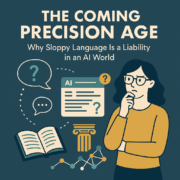So if this isn’t really AI, what exactly is it doing?
Large Language Models (LLMs) like ChatGPT can feel almost magical—spitting out essays, solving math problems, even mimicking your writing style. But let’s get something straight: they’re not thinking. They don’t reason. They don’t understand. So what exactly is happening when an LLM generates a response?
Let’s break it down.
Prediction, Not Cognition
At their core, LLMs are next-word predictors. They work by analyzing massive amounts of text data and learning patterns about what words tend to appear together.
For example:
- You type: “I’m going to the…”
- The model might calculate:
- “store” = 41% likely
- “gym” = 22%
- “moon” = 3%
It doesn’t know what you mean. It doesn’t visualize you in sneakers or imagine a lunar trip. It just picks the most statistically likely word based on its training.
Now extend that logic across thousands of layers and billions of parameters—and you get paragraphs that sound insightful, articulate, even empathetic. But it’s still just prediction.
Why It Feels So Smart
Because language encodes intelligence.
The model has seen so much high-quality writing that its outputs often mirror the style, rhythm, and coherence of expert thought. That illusion of intelligence comes not from the machine thinking, but from it reproducing patterns of thoughtful language.
Think of it like this: if you memorize 10,000 clever quotes and sayings, you’ll sound brilliant at parties—even if you don’t fully grasp them.
That’s what LLMs do, but at scale.
There’s Logic—But It’s Not Human Logic
LLMs do have an internal logic, just not the kind we use.
Humans reason with cause and effect. We build chains of logic from goals, beliefs, and context. LLMs, by contrast, rely on statistical association. They “know” that certain phrases often go together, even if they have no idea why.
This is why they can:
- Write realistic-sounding arguments
- Finish your thoughts
- Solve coding problems
…but also why they can hallucinate facts or give contradictory answers. They don’t have a truth model. They don’t understand.
The Programming Analogy
Think of an LLM like autocomplete on steroids. If you’ve ever used code autocomplete in an IDE, it suggests what might come next. LLMs just do that at a much more complex level.
They have no awareness of what’s a good answer or bad—only what sounds like an answer someone might say.
So What Is It Good For?
If LLMs aren’t intelligent, why use them?
Because what they are good at—amplifying language—is extremely powerful.
They’re useful for:
- Drafting emails, reports, and documents
- Accelerating brainstorming
- Speeding up research or summarizing content
- Structuring information
They’re not good at:
- Moral reasoning
- Long-term planning
- Truth verification
- Independent decision-making
Final Thought: It’s Not a Brain—It’s a Mirror
LLMs don’t think. They reflect.
They reflect our language, our ideas, and our knowledge back at us. When they impress us, they’re really showing us the best version of what we’ve already said. And when they fail, it’s often because we didn’t give them enough clarity to reflect something useful.
So don’t mistake coherence for consciousness.
And don’t call it Artificial Intelligence.
It’s Language Amplification.
And that’s more than enough to change everything.







Leave a Reply
Want to join the discussion?Feel free to contribute!